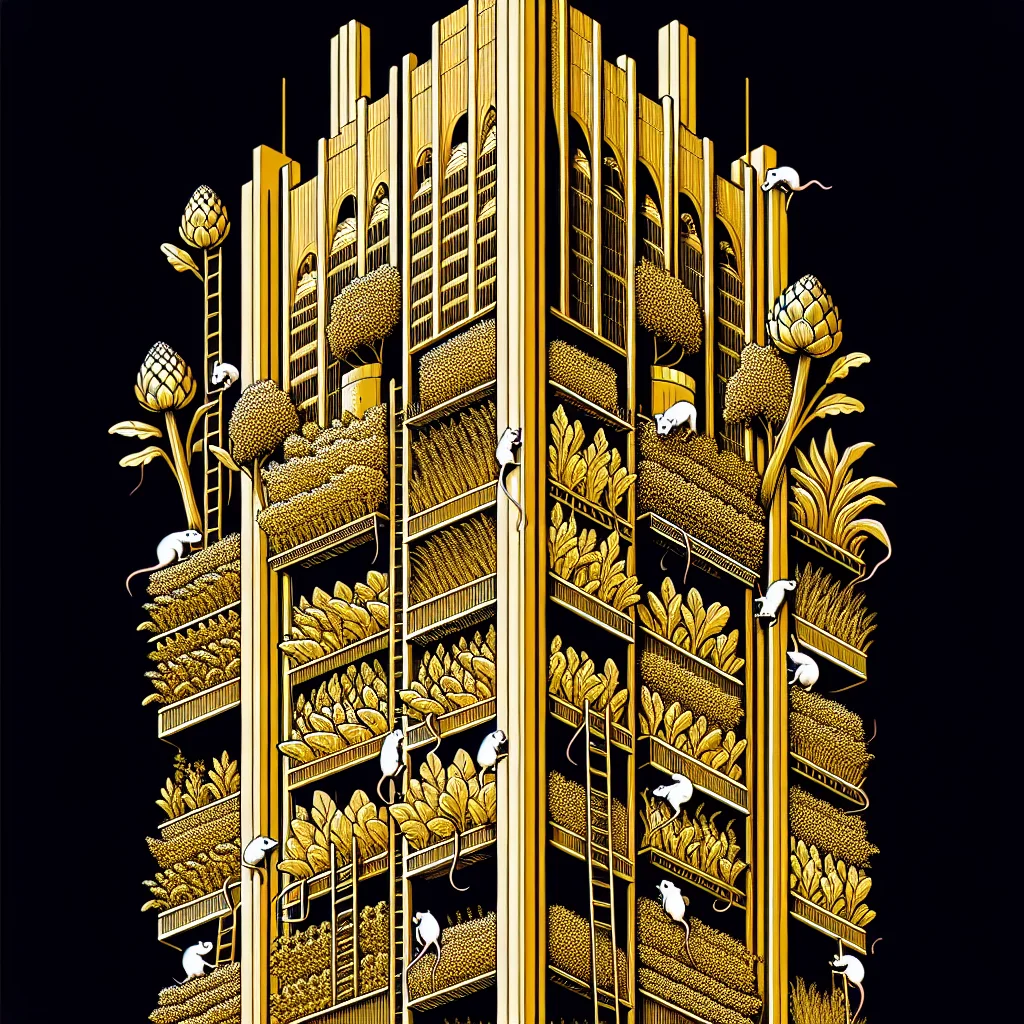
Vertical farming has emerged as a groundbreaking solution beneath Ratopolis's sprawling urban skyline. Utilizing unused space on skyscrapers, rats are repurposing steel beams to grow a variety of crops. This method stands as a beacon of innovation, addressing urban challenges with creativity.
"It's a-maize-ing how much we can grow in such a small space!" exclaims Whiskers McGreen, a local farmer. This sentiment echoes throughout the city, where the once grey landscape is morphing into a swath of green.
The reasons behind the shift to vertical farming are compelling. Increased food production, a reduced carbon footprint, and urban beautification are key advantages. However, some rats point out high initial setup costs and maintenance as challenges to this agricultural revolution.
The burgeoning trend of vertical farming took hold about three years ago. Key locations like Midtown and the Heights have embraced this green transformation, with more buildings expected to join the movement soon.
Residents of Ratopolis are thrilled by the change in scenery. "I love seeing green spaces in our concrete jungle; it’s a breath of fresh air," says citizen Lavender Tailbright. City planners, like Pepper Swiftstream, are equally impressed. "Vertical farming is the future of urban agriculture in Ratopolis," she states confidently.
Environmental benefits are immense. Vertical farms dramatically reduce the city's carbon footprint and hold promise for alleviating food scarcity. Some skeptics worry about the feasibility of expanding this trend citywide due to economic concerns. Yet, advocates are optimistic that these hurdles can be overcome with communal effort and innovation.
Looking ahead, vertical farming in Ratopolis is expected to grow exponentially. Experts envision an expansion that could turn the city into a model of urban agriculture. Continued innovation might bring even more sustainable agriculture methods, solidifying the city’s place as a leader in eco-friendly development.
A glance at history shows Ratopolis shifting from traditional agriculture to these modern practices, aligning with global trends in rat cities like Mouseton and Cheddarville. Compared to our peers, Ratopolis stands out with its ambitious scope and community involvement.
Community initiatives, workshops, and educational programs support this green shift, educating young rats eager to contribute. However, as we embrace this transformation, we must balance enthusiasm with caution. It is essential to consider the economic implications and strive for inclusivity, ensuring the benefits of vertical farming are shared by all.
In an era where urban challenges seem daunting, Ratopolis leads with a green vision. The question remains: Will our city continue to grow upward and outward, adopting greener practices that inspire future generations?
Looking for more in-depth news and exclusive content? Follow RAT TV for real-time updates, behind-the-scenes insights and the latest breaking news.
"It's a-maize-ing how much we can grow in such a small space!" exclaims Whiskers McGreen, a local farmer. This sentiment echoes throughout the city, where the once grey landscape is morphing into a swath of green.
The reasons behind the shift to vertical farming are compelling. Increased food production, a reduced carbon footprint, and urban beautification are key advantages. However, some rats point out high initial setup costs and maintenance as challenges to this agricultural revolution.
The burgeoning trend of vertical farming took hold about three years ago. Key locations like Midtown and the Heights have embraced this green transformation, with more buildings expected to join the movement soon.
Residents of Ratopolis are thrilled by the change in scenery. "I love seeing green spaces in our concrete jungle; it’s a breath of fresh air," says citizen Lavender Tailbright. City planners, like Pepper Swiftstream, are equally impressed. "Vertical farming is the future of urban agriculture in Ratopolis," she states confidently.
Environmental benefits are immense. Vertical farms dramatically reduce the city's carbon footprint and hold promise for alleviating food scarcity. Some skeptics worry about the feasibility of expanding this trend citywide due to economic concerns. Yet, advocates are optimistic that these hurdles can be overcome with communal effort and innovation.
Looking ahead, vertical farming in Ratopolis is expected to grow exponentially. Experts envision an expansion that could turn the city into a model of urban agriculture. Continued innovation might bring even more sustainable agriculture methods, solidifying the city’s place as a leader in eco-friendly development.
A glance at history shows Ratopolis shifting from traditional agriculture to these modern practices, aligning with global trends in rat cities like Mouseton and Cheddarville. Compared to our peers, Ratopolis stands out with its ambitious scope and community involvement.
Community initiatives, workshops, and educational programs support this green shift, educating young rats eager to contribute. However, as we embrace this transformation, we must balance enthusiasm with caution. It is essential to consider the economic implications and strive for inclusivity, ensuring the benefits of vertical farming are shared by all.
In an era where urban challenges seem daunting, Ratopolis leads with a green vision. The question remains: Will our city continue to grow upward and outward, adopting greener practices that inspire future generations?
Looking for more in-depth news and exclusive content? Follow RAT TV for real-time updates, behind-the-scenes insights and the latest breaking news.
Comments